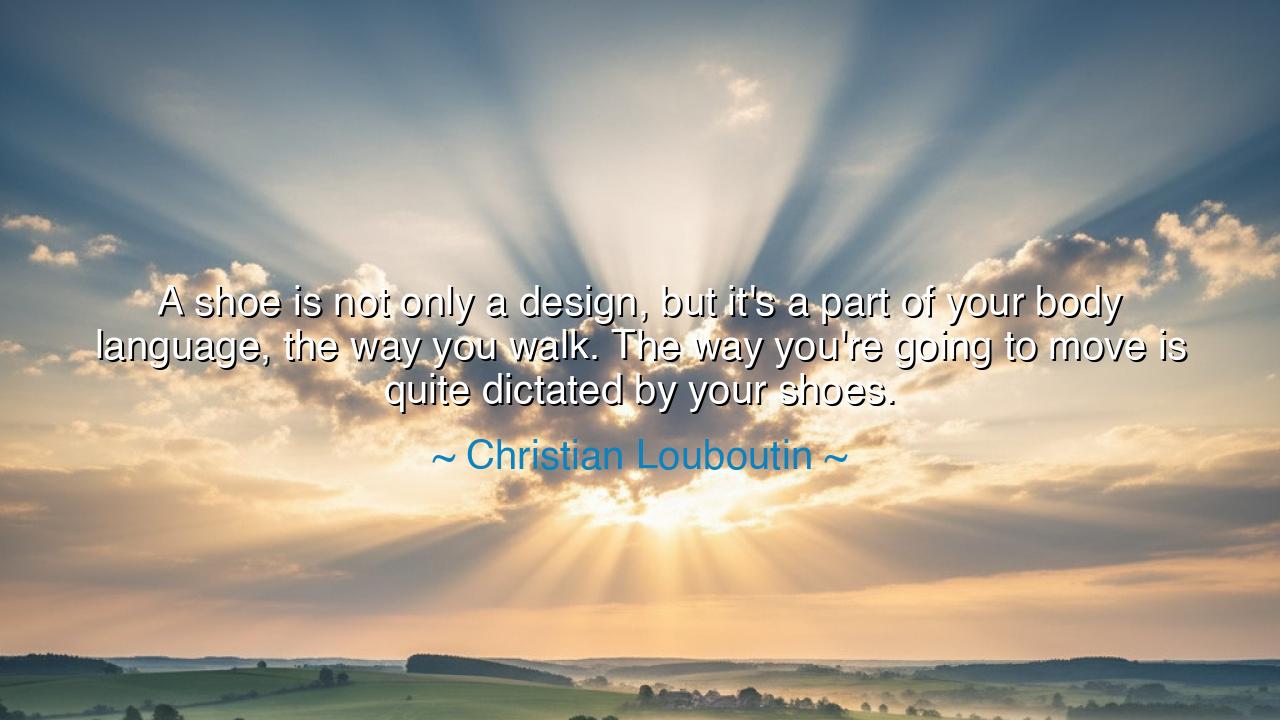
A shoe is not only a design, but it's a part of your body
A shoe is not only a design, but it's a part of your body language, the way you walk. The way you're going to move is quite dictated by your shoes.






The master craftsman of footwear, Christian Louboutin, once declared: “A shoe is not only a design, but it's a part of your body language, the way you walk. The way you're going to move is quite dictated by your shoes.” In these words lies not just the philosophy of fashion, but a meditation on the unity between form and being, design and soul, object and movement. For Louboutin, a shoe is not a mere ornament nor a vessel for the foot; it is an extension of the self, a visible manifestation of one’s confidence, rhythm, and essence. The shoe, he suggests, becomes a language — silent yet eloquent — through which the body speaks to the world.
Louboutin, who rose from humble beginnings in Paris to become a legend of design, understood that beauty and function cannot be separated. His creations — the red-soled shoes, now iconic across the globe — were not born merely from style but from an understanding of movement. He watched how people walked: the sway of a hip, the tilt of a head, the poise of one who feels seen. From these observations came a revelation — that design, when done with awareness, transforms behavior. A shoe, properly made, can change not only how one walks, but how one exists in space. The heel lifts the posture, the arch demands balance, the line of the design channels confidence. Thus, the shoe does not follow the body — it shapes it.
The ancients, too, understood this principle. The Greeks, who worshiped proportion, designed sandals not merely for protection, but to mirror the balance of the human frame. The Roman soldier’s sandal, laced firmly and cut to move with the leg, gave him both strength and grace. Centuries later, the samurai of Japan bound their feet in wooden geta — not for comfort, but to discipline their stride and remind them of their dignity. In every culture, the shoe has symbolized something deeper than attire: it is the meeting of matter and motion, a crafted object that influences the spirit of its wearer.
Louboutin’s insight also reflects a universal truth about design itself — that every act of creation carries the power to influence human behavior. A chair changes how we sit, a house changes how we dwell, a city changes how we live. Likewise, a shoe changes how we walk, how we feel, how we present ourselves to the world. The designer, therefore, is not a mere decorator, but a kind of psychologist of motion, shaping not only objects but experiences. In the rhythm of steps and the elegance of stride, one can read the invisible dialogue between human purpose and the tools we create to express it.
Consider, for a moment, the tale of Audrey Hepburn, whose graceful walk became her signature. The story goes that designer Salvatore Ferragamo crafted for her a pair of low, elegant ballet-style shoes — a design that matched her personality: poised, confident, yet modest. Those shoes did more than adorn her feet; they defined her movement. The way she glided, the way she seemed light yet grounded, became part of her identity. Her shoes, like Louboutin’s words, showed that what we wear not only reflects us — it refines us. In every step, the harmony between design and being is revealed.
But there is also a deeper wisdom hidden in Louboutin’s reflection — one that extends beyond fashion. He reminds us that the external and the internal are never separate. Just as the shoe dictates the walk, our surroundings, our choices, and our tools influence the rhythm of our inner life. The way we move through the world — with grace or hesitation, with pride or insecurity — is shaped by what we create and what we choose to carry with us. To walk well, one must choose well; to move freely, one must design one’s world with care.
So, my listener of the future, take this lesson to heart: the things you design, and the things you wear, are not trivial. They are part of your language, part of how you declare to the world, “This is who I am.” Choose objects that lift you, that make you stand taller, that align your movements with your spirit. Whether you wear fine leather or humble cloth, walk as if the ground beneath you is sacred — for in truth, every step is a conversation between body and soul.
For as Christian Louboutin teaches, a shoe — like all true design — is not mere appearance; it is expression. It speaks without words, moves without speech, and tells the story of the self in motion. Walk, then, not only with style, but with awareness — for in every stride you take, your design becomes your destiny.






AAdministratorAdministrator
Welcome, honored guests. Please leave a comment, we will respond soon